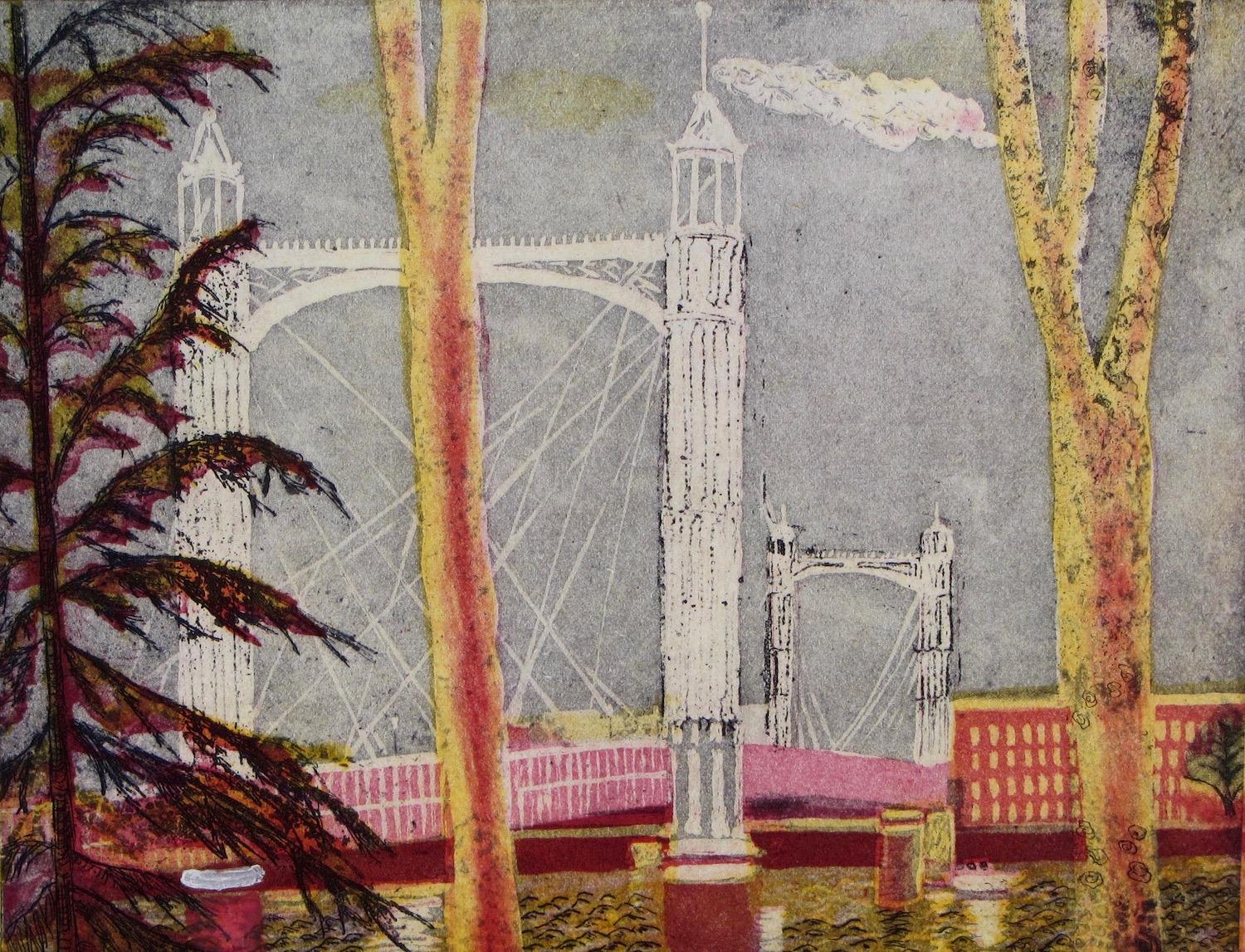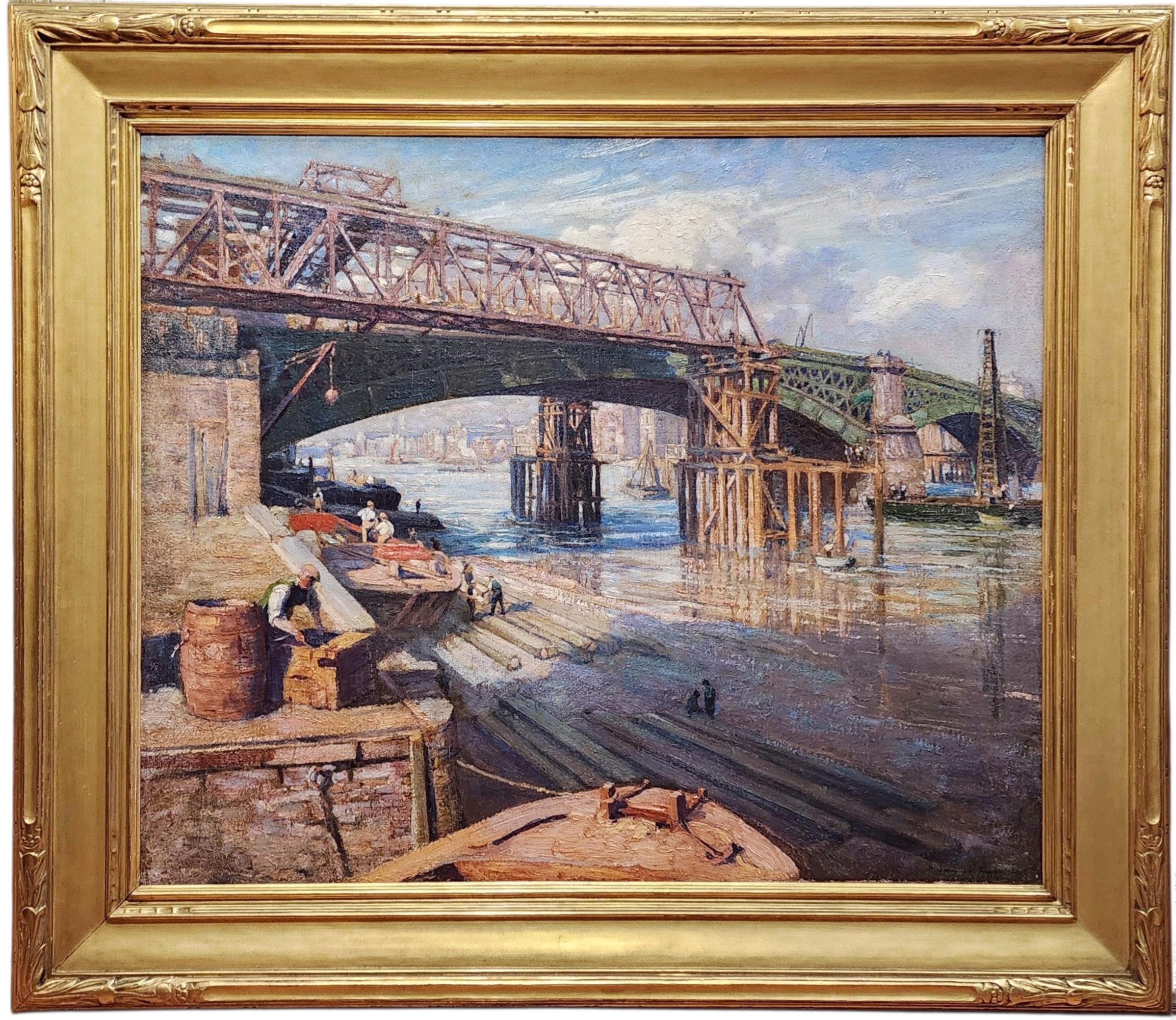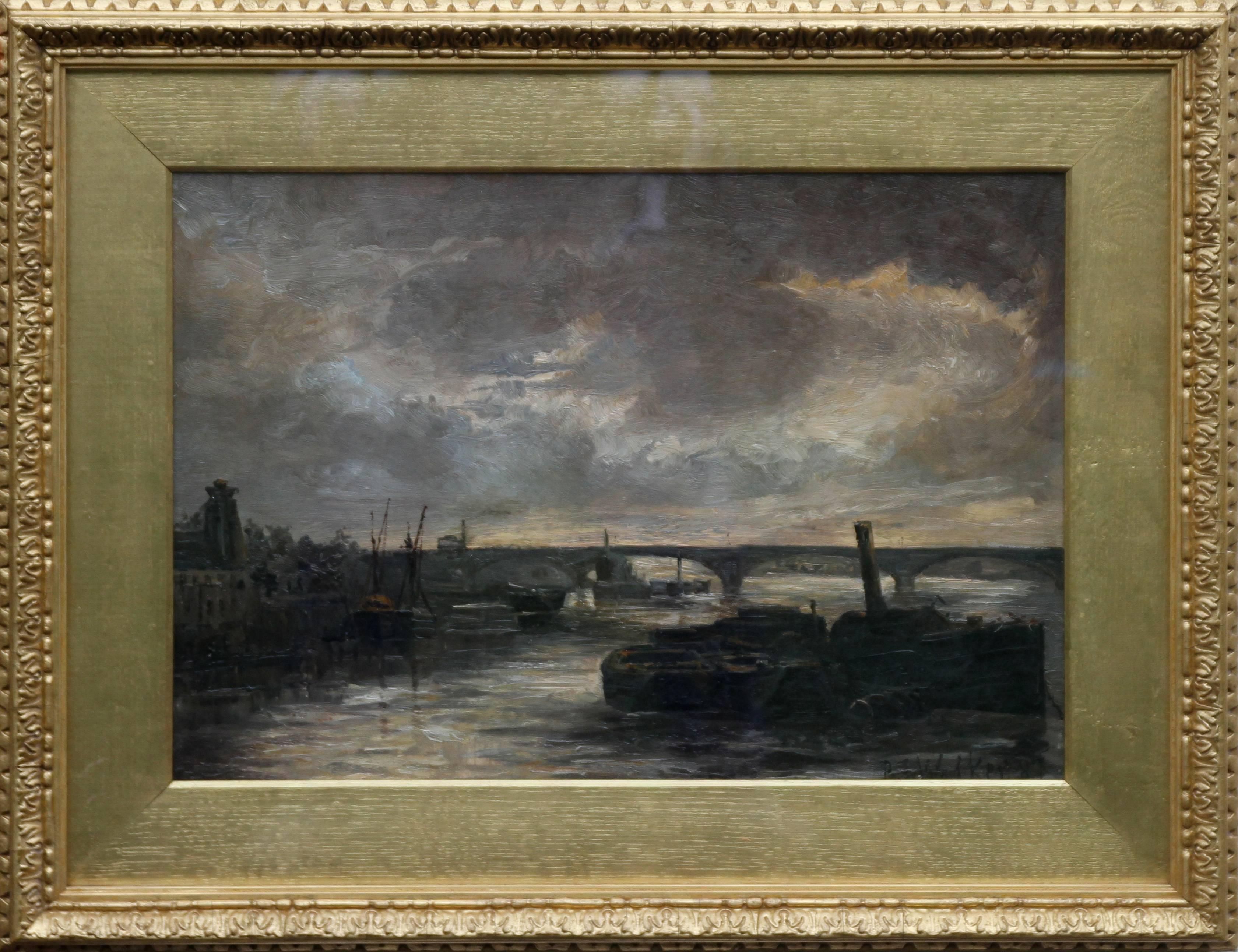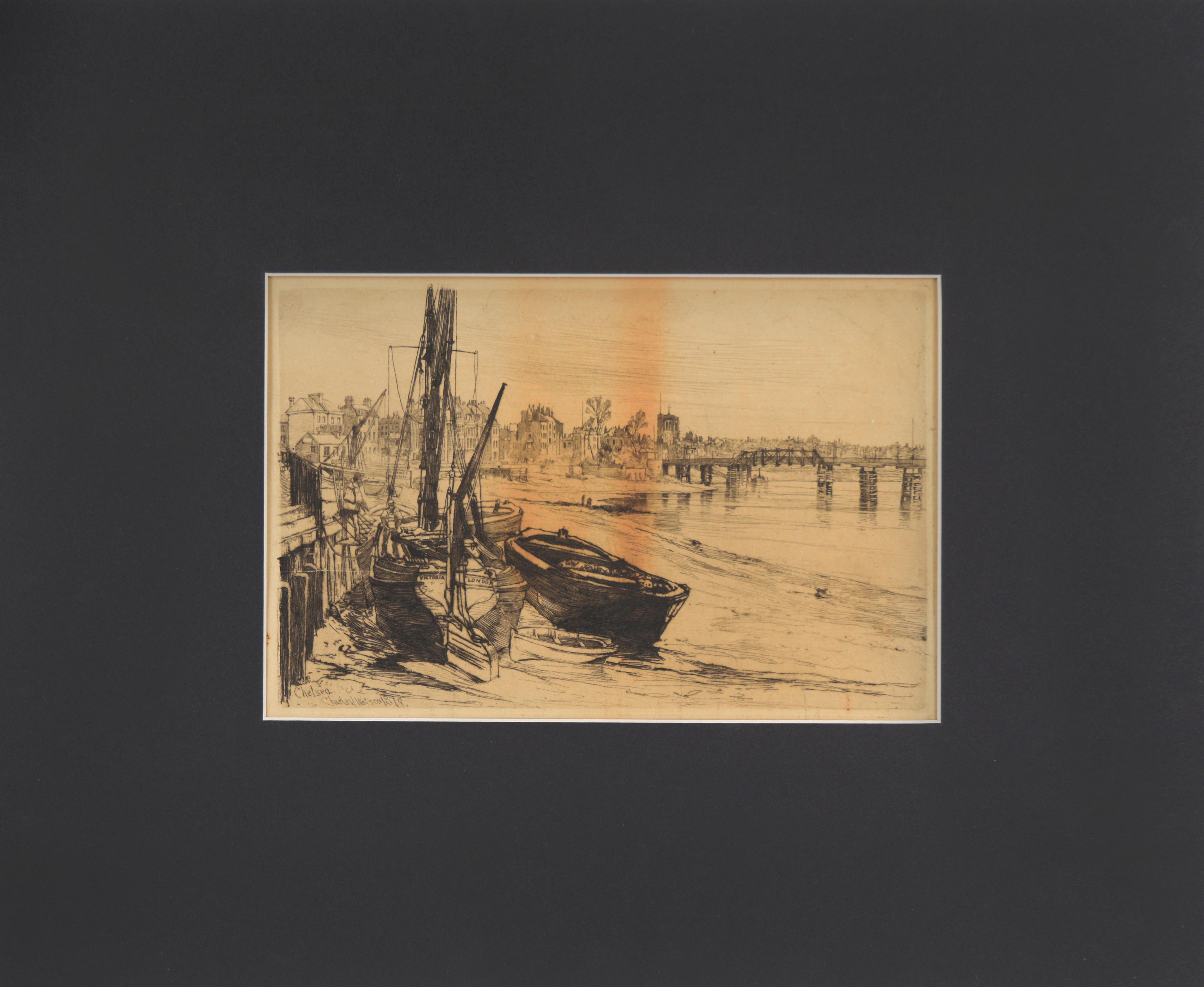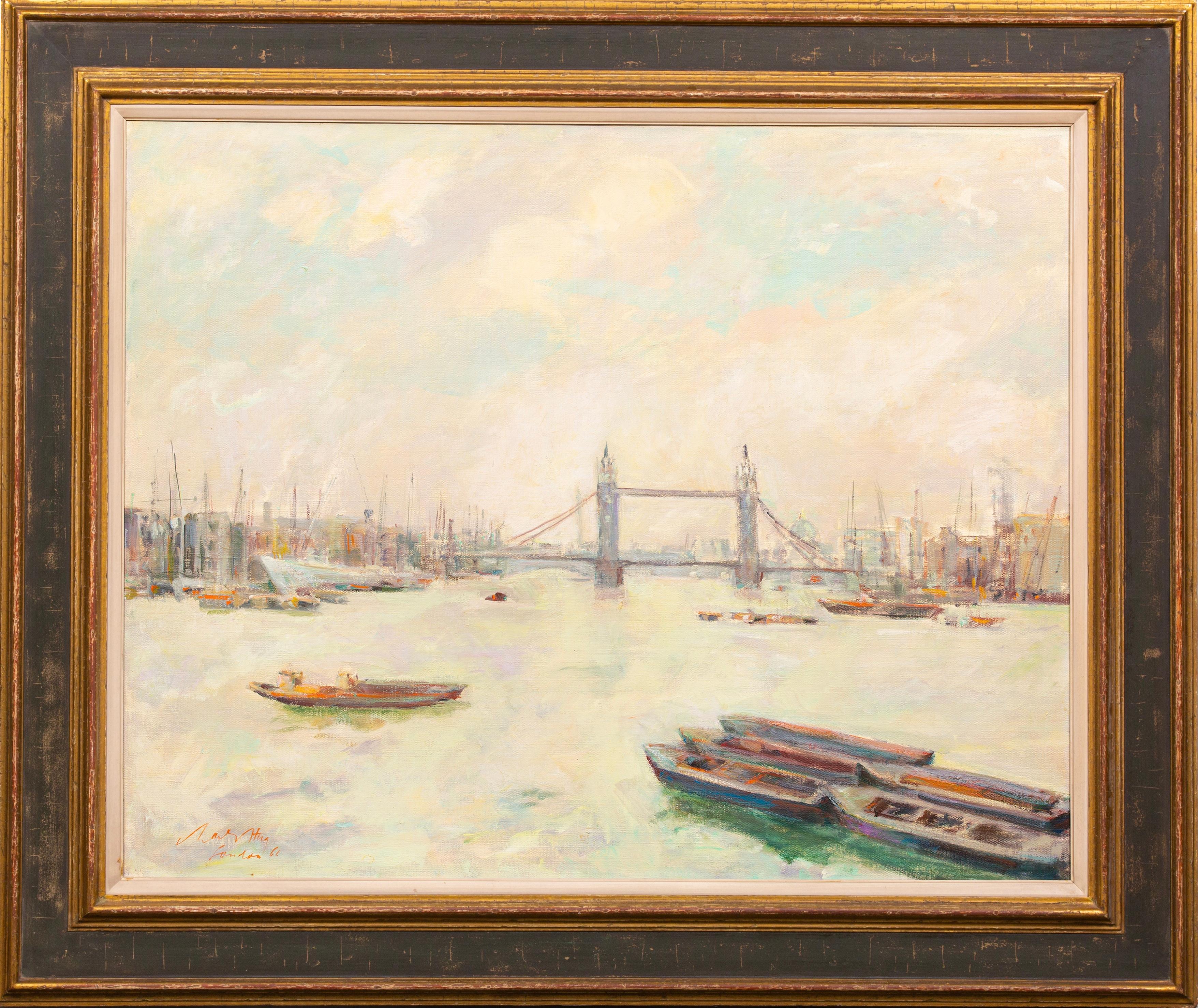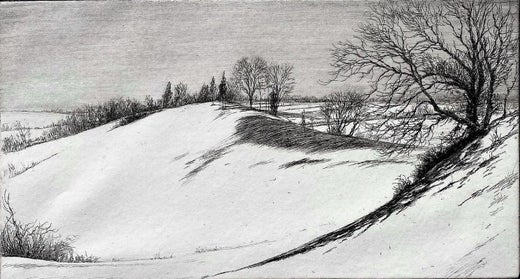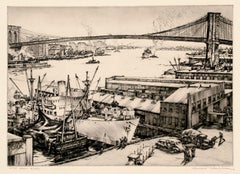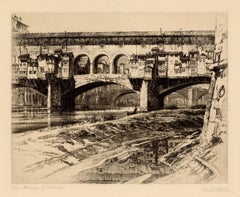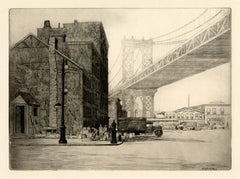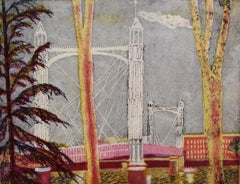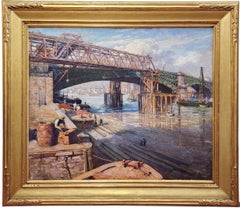Items Similar to Hungerford Bridge, London
Want more images or videos?
Request additional images or videos from the seller
1 of 3
Kerr EbyHungerford Bridge, London1929
1929
$400
£304.73
€347.77
CA$562.09
A$612.58
CHF 324.39
MX$7,357.78
NOK 4,106.85
SEK 3,775.84
DKK 2,597.48
About the Item
Kerr Eby 'Hungerford Bridge, London', etching and sandpaper ground, 1929, edition 90, Giardina 144. Signed, titled, and annotated 'Ed 90' in pencil. Signed again in the bottom right sheet corner. A fine, atmospheric impression, with delicate plate tone, on cream wove paper; the full sheet with margins (1 1/2 to 1 5/8 inches), in excellent condition. Matted to museum standards, unframed.
Hungerford Foot Bridge spans the River Thames in London, between Westminster Bridge and Waterloo Bridge. Eby visited Great Britain and France during 1924 and 1925.
Impressions of this work are in the permanent collection of the following institutions: American Academy and Institute of Arts and Letters, Arizona State University, Boston Public Library, Davison Art Center (Wesleyan University), Herbert F, Johnson Museum of Art, Huntington Museum of Art, Hood Museum of Art (Dartmouth College), Metropolitan Museum of Art, Montgomery Museum of Fine Arts, National Museum of American Art, New York Public Library, Smithsonian Museum of American Art.
ABOUT THE ARTIST
Kerr Eby was born in 1890 in Tokyo, Japan, the son of Methodist missionaries from Canada. The family returned to Vancouver when Eby was only three, and he grew up studying art encouraged by his parents as his mother was from a family of prominent artists. By age twelve, he had lived in Vancouver, Kingston, Toronto and Bracebridge where he found work as a ‘printer’s devil’ on the local Bracebridge newspaper.
After graduating from high school in 1907, Eby moved to New York City to study art, first at the Pratt Institute, and later at the Art Students League. He enrolled in art classes at Pratt Institute while working for a lithographic firm earning $4.00 a week. His pay barely covered his room and drawing supplies. Within a year, starving and feeling defeated, he returned to Canada and was employed by a surveying party in Northern Ontario. Eby gradually regained his dream of becoming an artist, and in his spare time, he began to draw the surrounding wilderness landscapes. By fall he had returned to New York to attend night classes at the Art Students League while working for another lithographic firm. He spent several more summers surveying in Northern Ontario before he was able to make a living as an illustrator. During this period he formed several friendships with influential artists including John Henry Twachtman and Childe Hassam and joined a summer artists' colony founded by them at Cos Cob, Connecticut. He supported himself by working as a magazine illustrator and at the American Lithographic Company. Through diligent study and practice, Eby refined both his drawing and printmaking techniques.
In 1917, when the United States entered World War I, Eby joined the U.S. Army. Failing to obtain a commission as an artist, he was assigned first to ambulance duty and later as a sergeant in the 40th Engineers in France. He spent most of WWI on the front line as a camouflager of the field artillery ‘big guns”. On his time off duty, he would sketch everything he witnessed, from the explosive big guns and men in action to the dead soldiers in the field. He sent the drawings home each week, and upon his return from the war, they became the basis for his first successful group of etchings. He continued creating his war-related prints throughout the 1920s and '30s as his work became widely exhibited Frederick Keppel, the renowned print dealer and a relative of Eby, became the exclusive agent for many of his print editions.
With another global conflict beginning in the mid-1930s, Eby wanted to show the world the true face of war. In 1935, he published a book of this prints, entitled simply ‘War’. These powerful works depict the horror and disillusionment he experienced in combat and remain some of the most compelling anti-war images ever produced in this country. When the United States declared war in 1941, Eby tried to enlist but was turned down because of his age. He received his opportunity to serve, however, when Abbott Laboratories developed its combat artist program. Between October 1943 and January 1944, he traveled with Marines in the South Pacific and witnessed some of the fiercest fighting of the war, landing with the invasion force at Tarawa. While living three weeks in a foxhole in Bougainville Island, Papua New Guinea, he contracted a tropical disease, from which he never recovered. He completed his final drawings for Abbott but was unable to complete the etchings he intended to make. He died in Norwalk, Connecticut in 1946.
Eby was an Associate of the National Academy NA (1930); National Academy of Design (1934); Society of American Etchers; Chicago Society of Etchers; Philadelphia Society of Etchers; National Institute of Arts and Letters. Kerr Eby's work can be found in numerous museum and public collections.
- Creator:Kerr Eby (1890 - 1946, American)
- Creation Year:1929
- Dimensions:Height: 8.38 in (21.29 cm)Width: 17.25 in (43.82 cm)
- Medium:
- Movement & Style:
- Period:
- Condition:
- Gallery Location:Myrtle Beach, SC
- Reference Number:Seller: 1035981stDibs: LU53234180121
Kerr Eby
Kerr Eby was born in 1890 in Tokyo, Japan, the son of Methodist missionaries from Canada. Returning to that country when he was three, Eby grew up studying art, which his parents encouraged, as his mother came from a family of prominent artists. Harold Kerr Eby was born to Canadian Methodist missionaries in Tokyo, Japan, on October 19, 1889. At the age of three his family moved to Vancouver, B.C. and by the time he was twelve, he had lived in Vancouver, Kingston, Toronto and Bracebridge. He worked as a 'printer's devil' on the Bracebridge paper, and at fifteen he took his savings and moved to New York with the dream of becoming an artist After graduating from high school in 1907, Eby moved to New York City to study art, first at the Pratt Institute, and later at the Art Students League.. He enrolled in art classes at Pratt Institute while working for a lithographic firm earning $4.00 a week. His pay barely covered his room and drawing supplies. Within a year, life became desperate for the young artist. Starving and feeling defeated, he left in the spring for home in Canada and was employed by a surveying party in Northern Ontario. While in this northern wilderness, Eby regained his dream of becoming an artist, and in his spare time he started to draw his surroundings. By fall he had saved enough money to return to New York. He attended night classes at the Art Students League while working for another lithographic firm. He spent several more summers surveying in Northern Ontario before he was able to make a living as an illustrator. During this period he formed a number of influential friendships with major artists such as John Henry Twachtman and Childe Hassam and joined a summer artists' colony founded by them at Cos Cob, Connecticut. He supported himself by working as a magazine illustrator and at the American Lithographic Company. Through study and practice, Eby refined both his drawing and printing techniques. Eby was an Associate of the National Academy NA (1930); National Academy of Design (1934); Society of American Etchers; Chicago Society of Etchers; Philadelphia Society of Etchers; National Institute of Arts and Letters. Kerr Eby's work can be found in these collections of the Library of Congress, The Fine Arts Museums of San Francisco, Harvard Art Museums, New York Public Library, Navy Art Collection.
About the Seller
5.0
Recognized Seller
These prestigious sellers are industry leaders and represent the highest echelon for item quality and design.
Platinum Seller
Premium sellers with a 4.7+ rating and 24-hour response times
Established in 1995
1stDibs seller since 2016
334 sales on 1stDibs
Typical response time: 1 hour
Associations
International Fine Print Dealers Association
- ShippingRetrieving quote...Shipping from: Myrtle Beach, SC
- Return Policy
More From This Seller
View All'The East River', Brooklyn Bridge — Mid-Century Realism, New York City
By Lawrence Wilbur
Located in Myrtle Beach, SC
Lawrence Nelson Wilbur (1897-1988), 'The East River', drypoint, edition 65, 1946. Signed, titled, and annotated 'A. Jones Proof 1946' in pencil. Signed and dated in the plate, lower ...
Category
1940s American Modern Landscape Prints
Materials
Drypoint
'Bridges of Florence' — Firenze Impressionism
Located in Myrtle Beach, SC
Alonzo C. Webb, 'Bridges of Florence', etching, 1929, edition 100. Signed and titled in pencil. Signed and dated in the plate, lower left. A superb, richly-inked impression, in warm ...
Category
1920s American Impressionist Figurative Prints
Materials
Etching
Manhattan Bridge — 1920s New York City
By George Stimmel
Located in Myrtle Beach, SC
'Manhattan Bridge', etching, c. 1920, proofs only. Signed in ink in the image, lower right. A fine, rich impression, in warm black ink, on cream wove ...
Category
1920s American Realist Landscape Prints
Materials
Etching
'Brooklyn Bridge' — Iconic New York City Landmark
By Luigi Kasimir
Located in Myrtle Beach, SC
Luigi Kasimir, 'Brooklyn Bridge', color etching with aquatint, 1927, edition 100. Signed in pencil.
A superb impression, with fresh colors, on heavy, cream wove paper; with margins...
Category
1920s American Modern Landscape Prints
Materials
Etching, Aquatint
'Delaware River Bridge' — Mid-Atlantic Regionalism
By Anton Schutz
Located in Myrtle Beach, SC
Anton Schutz, 'Delaware Bridge' (Delaware, New Jersey), etching, c. 1927. Signed in pencil. A superb, richly-inked impression, with skillfully wiped plate tone, on BFK Rives, cream wove paper, the full sheet with margins (1 1/2 to 2 1/8 inches), in excellent condition. Archivally matted to museum standards, unframed.
Image size 11 7/8 x 8 7/8 inches (302 x 225 mm); sheet size 15 7/8 x 12 1/4 inches (403 x 311 mm).
ABOUT THIS IMAGE
The Benjamin Franklin Bridge, originally named the Delaware River...
Category
1920s Realist Figurative Prints
Materials
Etching
'George Washington Bridge (Under Construction)' — 1920s New York City
By Otto Kuhler
Located in Myrtle Beach, SC
Otto Kuhler, 'George Washington Bridge' (under construction) also titled 'The Cables That Hold it All', etching, 1928, edition unknown. An uns...
Category
1920s American Modern Figurative Prints
Materials
Etching
You May Also Like
Vauxhall Bridge London 1951 - British Post Impressionist landscape oil painting
Located in Hagley, England
This superb Post Impressionist London landscape oil painting is by noted Slade School trained artist Bertram Nicholls. Painted in 1951 and with excellent provenance, the location is ...
Category
1950s Post-Impressionist Landscape Paintings
Materials
Oil
A Glimpse of Albert Bridge
Located in Deddington, GB
A Glimpse of Albert Bridge by Karen Keogh [2015]
limited_edition
Etching on Paper
Edition number 75
Image size: H:16 cm x W:20 cm
Complete Size of Un...
Category
21st Century and Contemporary Contemporary Figurative Prints
Materials
Paper, Etching
Building The Southwark Bridge, London, England, River Thames, Genre
Located in Grand Rapids, MI
Henry Samuel Teed (British, 1883 - 1916)
Signed: H. Samuel Teed 1914 (Lower, Right
" Building Southwark Bridge ", 1914
(Over the Thames, London)
Oil on Canvas
30" x 36"
Housed i...
Category
Early 20th Century Realist Landscape Paintings
Materials
Canvas, Oil
Thames at Battersea - British Impressionist art Victorian London oil painting
By Philip F. Walker
Located in Hagley, England
A stunning view of the Thames at Battersea which Whistler would have been proud of. A superb 1887 impressionist view of London with the river Thame...
Category
19th Century Impressionist Landscape Paintings
Materials
Oil
Old Battersea Bridge View, Chelsea, 1879 - Etching on Paper
Located in Soquel, CA
Old Battersea Bridge View, Chelsea, 1879 - Etching on Paper
Black and white 1897 etching titled "Old Battersea Bridge View" by Charles John Watson (British, 1846-1947). View at Chelsea from the bank of the Thames, with boats moored in foreground at left, Old Battersea Bridge in background, and Chelsea Old Church beyond.
Signed and dated "Charles J Watson...
Category
1870s Impressionist Landscape Prints
Materials
Paper, Ink, Etching
$360 Sale Price
20% Off
'River Thames and the Tower Bridge, London' by Charles Hug ( 1899 – 1979 )
Located in Knokke, BE
Charles Hug
St. Gallen 1899 – 1979 Zurich
Swiss Painter
'River Thames and the Tower Bridge, London'
Signature: signed lower left and dated 'Charles Hug, London '61'
Medium: oil on ...
Category
Mid-20th Century Impressionist Landscape Paintings
Materials
Canvas, Oil
More Ways To Browse
Antique Bridges
Miami Street Art
Nebraska Artist
Painting Spanish Scene
Paintings Of Copenhagen
Paintings Of Rome Italy
Pez Art
Rally Car
Renee French
Rock N Roll Art
Textile Fiber Art Abstract
Tunisia Painting
Valley Forge
Vintage Brooklyn Sign
Watch Lot
A Chorus Line
Antique Anatomical Drawings
Antique Goddess Painting

